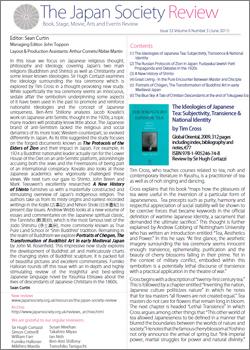Issue 33 (June 2011, Volume 6, Number 3)

In this issue we focus on Japanese religious thought, philosophy and ideology, covering Japan’s two main religions (Buddhism and Shinto) as well as Christianity and some lesser known ideologies.
Sir Hugh Cortazzi examines the ideology surrounding the tea ceremony which is explored by Tim Cross in a thought-provoking new study. While superficially the tea ceremony seems an innocuous, sedate affair the symbolism underpinning some aspects of it have been used in the past to promote and reinforce nationalist ideologies and the concept of Japanese uniqueness.
Ben-Ami Shillony analyzes Jacob Kovalio’s work on Japanese anti-Semitic thought in the 1920s, a topic many readers will probably know little about. The Japanese brand of anti-Semitism lacked the religious and social dynamics of its more toxic Western counterpart, so evolved differently in Japan. As its title suggested the study focuses on the forged documents known as The Protocols of the Elders of Zion and their impact in Japan. For example, in 1924 a Buddhist nationalist leader actually ran for the Lower House of the Diet on an anti-Semitic platform, astonishingly accusing both the Jews and the Freemasons of being part of an international conspiracy. Kovalio also looks at those Japanese academics who vigorously challenged these views.
We next turn our gaze to Shinto. John Breen and Mark Teeuwen’s excellently researched A New History of Shinto furnishes us with a masterfully constructed and stimulating overview of Japan’s indigenous religion. The authors take us from its misty origins and earliest recorded writings in the Kojiki (古事記) and Nihon Shoki (日本書紀) to present day issues.
Andrew Webb looks at a new volume of essays and commentaries on the Japanese spiritual classic, the Tannisho (歎異抄), which is the most famous text of the Jodo Shinshu (浄土真宗), more commonly known as True Pure Land School or ‘Shin Buddhist’ tradition.
Remaining in the realm of Buddhism we explore Portraits of Chōgen, The Transformation of Buddhist Art in early Medieval Japan by John M. Rosenfield. This impressive new study explores the development of Buddhist art and meticulously charts the changing styles of Buddhist sculpture. It is packed full of beautiful pictures and excellent commentaries.
Fumiko Halloran rounds off this issue with an in-depth and highly stimulating review of the insightful and best-selling Japanese language novel by Yasuhisa Ebisawa about the lives of descendants of Japanese Christians in the 1860s.
Contents
- The Ideologies of Japanese Tea: Subjectivity, Transience & National Identity
- The Russian Protocols of Zion in Japan: Yudayaka/Jewish Peril Propaganda and Debates in the 1920s
- A New History of Shinto
- Great Living - In the Pure Encounter Between Master and Disciple
- Portraits of Chògen, The Transformation of Buddhist Art in early Medieval Japan
- The Blue Sky: A Tale of Christian Descendants at the end of Tokugawa Era
Contributors
Editor
Sean Curtin
Managing Editor
John Toppon
Layout & Production Assistants
Arthur Comets and Abbie Martin
Reviewers
Sir Hugh Cortazzi, Ben-Ami Shillony, Andrew Webb and Fumiko Halloran

